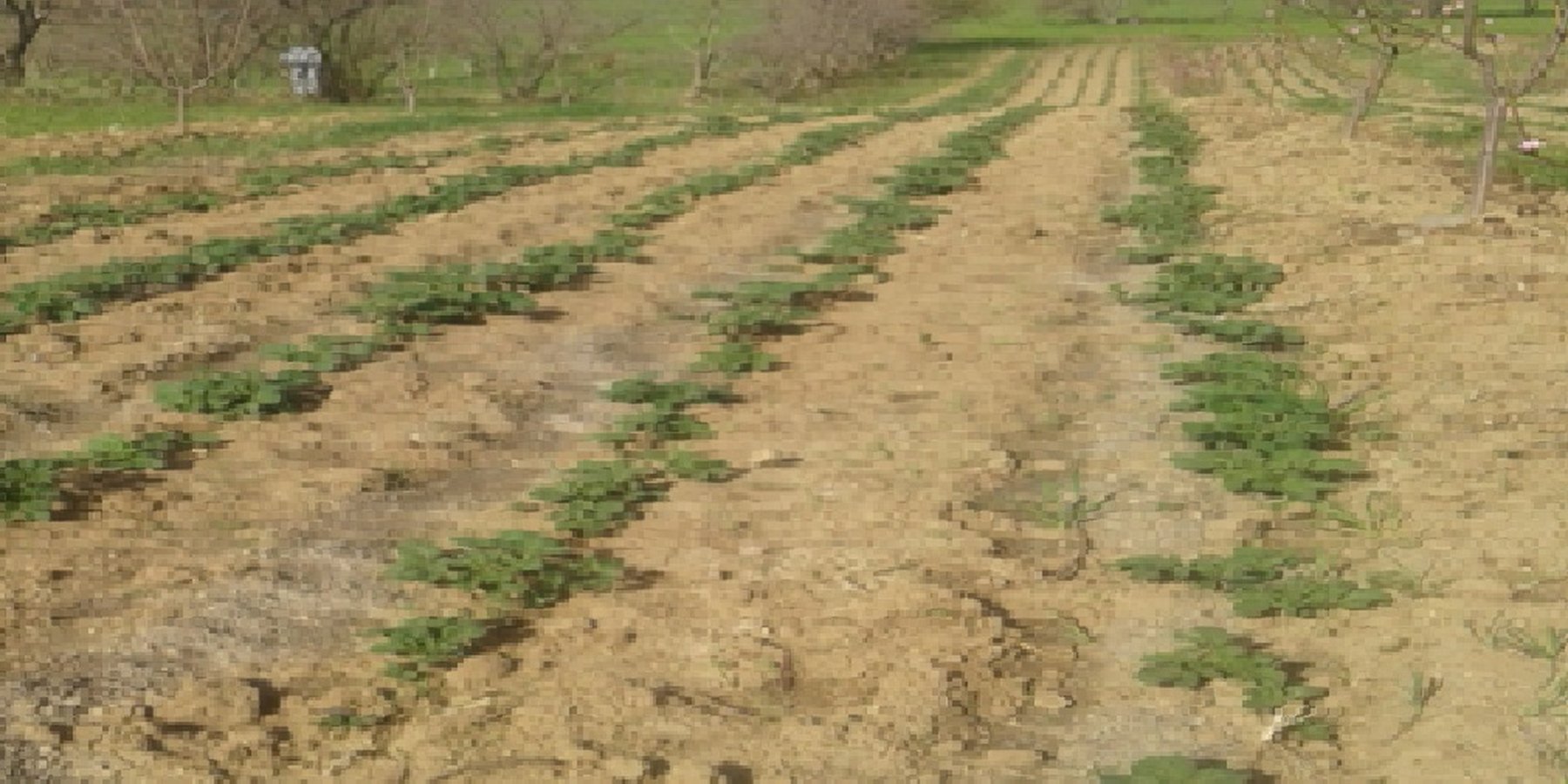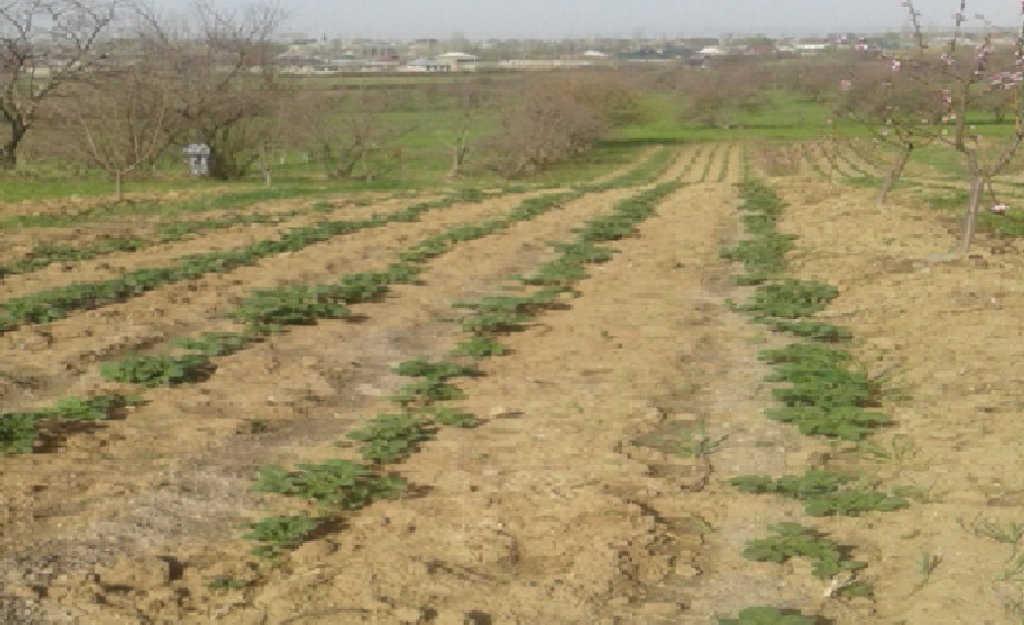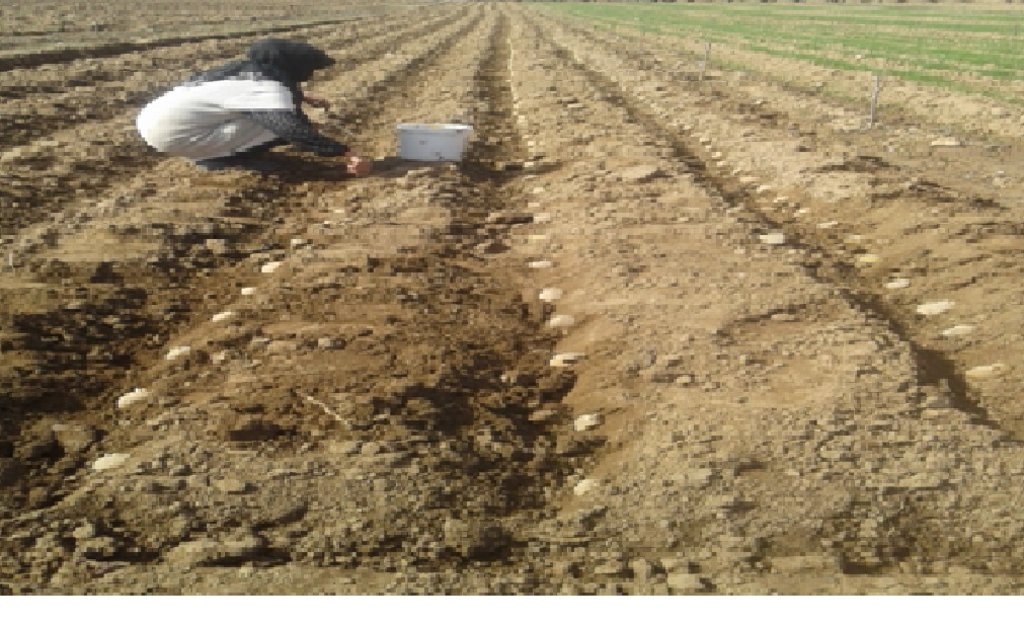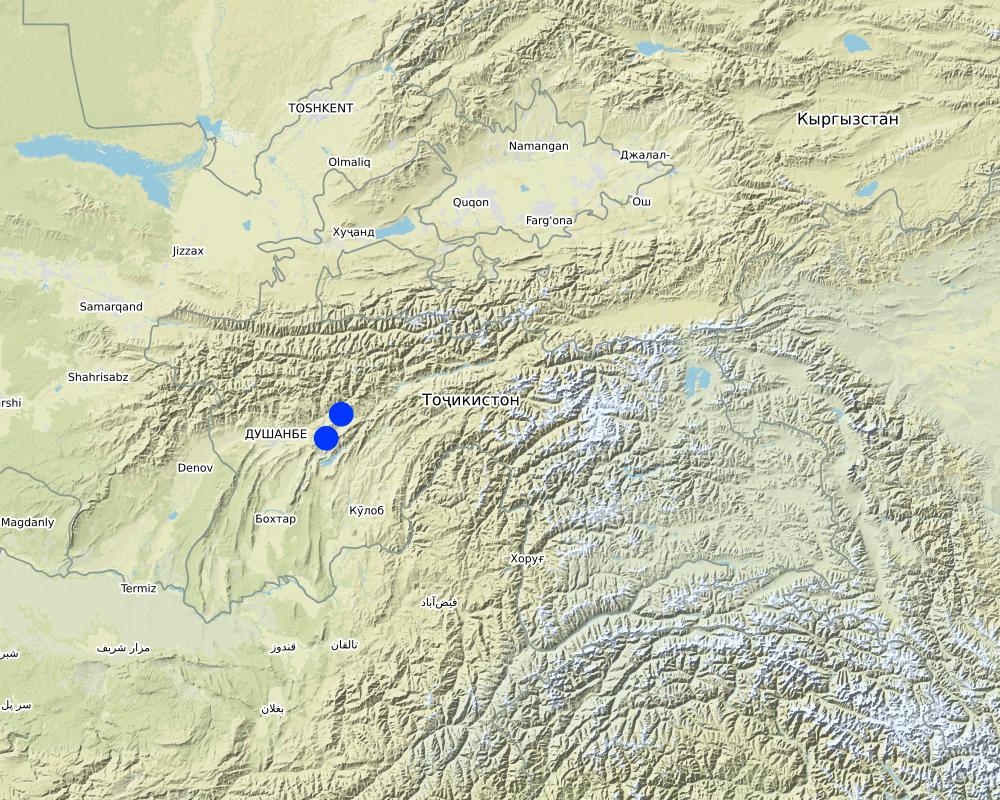Посев картошки без грядным методом для сохранения почвенного плодородия от эрозии и сокращения затрата труда на склонных землях. [Tajikistan]
- Creation:
- Update:
- Compiler: Rustam Kalandarov
- Editor: –
- Reviewer: Farrukh Nazarmavloev
Кишти картошка бе чуяк барои нигохдории хосилноки замин аз бодлеси ва ихтисори мехнат дар заминхои нишеби.
technologies_3688 - Tajikistan
View sections
Expand all Collapse all1. General information
1.2 Contact details of resource persons and institutions involved in the assessment and documentation of the Technology
land user:
Убайдуллоев Сироятулло , Изатуллоевич
93 304 39 93
Файзабадский район., поселок Дашти махтоби
Tajikistan
Name of project which facilitated the documentation/ evaluation of the Technology (if relevant)
Environmental Land Management and Rural Livelihoods (ELMAR)Name of the institution(s) which facilitated the documentation/ evaluation of the Technology (if relevant)
Youth Ecological Center, Tajikistan (Youth Ecological Center, Tajikistan) - Tajikistan1.3 Conditions regarding the use of data documented through WOCAT
When were the data compiled (in the field)?
05/02/2018
The compiler and key resource person(s) accept the conditions regarding the use of data documented through WOCAT:
Yes
1.4 Declaration on sustainability of the described Technology
Is the Technology described here problematic with regard to land degradation, so that it cannot be declared a sustainable land management technology?
No
Comments:
Этот технология неприводить к дегродасии зимли так как набарот оно улудшует и обогошает улудшению почвы но не смывает в почве микро и макро элементов нуждаюший растения.
2. Description of the SLM Technology
2.1 Short description of the Technology
Definition of the Technology:
Эту технологию можно использовать в горных и предгорных регионах, она не вызывает деградации почвы, сохраняет плодородие почвы и оберегает её от
смыва. Приемлема в богарных условиях обеспеченных влагой.
2.2 Detailed description of the Technology
Description:
Данная технология применяется в Файзабадском районе, в хозяйстве Карсанг. Природные условия предгорная богарная и условно поливная зона. Участок
находится на высоте 1200 м над уровнем моря, где годовая сумма осадков 550 - 750 мм. Ветровая зона. Местность сухая и умеренно влажная. Почва коричнево - карбонатная. Поливная вода в основном из горных родников . Зимой прохладно, летом жарко. Весной часто выпадают дожди. Землепользователи в основном занимаются садоводством, виноградарством, картофелеводством и частично, скотоводством. Местные жители давно занимаются выращиванием картофеля. В последние годы землепользователи сажают картошку не на грядках, а по сплошной выровненной почве. Участки в основном на равнине и склонах. Именно на склонах сажают картошку без грядок. Этот метод, по мнению землепользователей сокращает 2 культивационные работы не смывается плодородная почва, экономится полив. Этим методом можно использовать земли горных и предгорных участков где осадки выпадают в пределах от 700 - 800 мм. Использование земель рациональное а также экономится вода так как при этом методе полив проводят 2-3 раза, во время цветения. Землепользователям приемлема эта технология в годы когда выпадает 700 – 800 мм осадков. Эту технологию фермеры в горных и предгорных регионах, испольничают много лет. Основная цель сохранение плодородия почвы, зашита от смыва. При посеве картофеля, не нарушается почвенный покров верхнего слоя на глубину 0-30, 30-50 см. А также не происходит деградации почвы. В этих условиях картофель в основном сажают только рано весной. Перед посадкой почву подготавливают сплошной, обработкой. Посадка проводится по схеме 70 х 30 см. без грядо. Окучивают после первой культивации. В этих условиях проводятся полив 2-3 раза, мелким нормами.. Преимущество в том, что в сравнение грядочной посадкой сокращается две обработки (культивации) почвы. Землепользователи получают хороший урожай 25-30 тонн с одного гектара. Посадка без грядок проводится по схеме. Натягивается шпагат, копают щель по длине ряда сажают картофель и заделывают почву. Перед посадкой дают подкормку - навоз или нитро аммофос , картошку. Землепользователям эта технология нравится и они часто используют её повсеместно. Землепользователи даже используют совмещенный посев картошки с зеленью (например укроп, кинза, сельдерей и т.д.) До первой культивации зелень уже готова для сбора, её убирают и начинают проводить обработку картофеля. В настоящее время этот метод используют в долинных овощеводческих хозяйствах.
2.3 Photos of the Technology
General remarks regarding photos:
На фотографии приведена как посажено картошки на склонных землях без грядки для сохранения плодородия и смыв почвы.
2.5 Country/ region/ locations where the Technology has been applied and which are covered by this assessment
Country:
Tajikistan
Region/ State/ Province:
Файзабадский район, РРП
Further specification of location:
Хозяйства " Карсанг"
Comments:
Файзабадский район находиться на восточной части от сталици.
Map
×2.6 Date of implementation
Indicate year of implementation:
2010
If precise year is not known, indicate approximate date:
- 10-50 years ago
2.7 Introduction of the Technology
Specify how the Technology was introduced:
- as part of a traditional system (> 50 years)
- during experiments/ research
Comments (type of project, etc.):
Технология как инновация землепользователя и научно обоснованная.
3. Classification of the SLM Technology
3.1 Main purpose(s) of the Technology
- improve production
- reduce, prevent, restore land degradation
- adapt to climate change/ extremes and its impacts
3.2 Current land use type(s) where the Technology is applied

Cropland
- Tree and shrub cropping
Main crops (cash and food crops):
Основной сельскохозяйственная культура является картошка.
Comments:
Где принимается технология пахотная зона склоны и равнины богарные и условно богарные земли.
If land use has changed due to the implementation of the Technology, indicate land use before implementation of the Technology:
Ранше землю пользовали под зернобобовых культур
3.3 Further information about land use
Water supply for the land on which the Technology is applied:
- mixed rainfed-irrigated
Comments:
Основная часть землепользование является условно поливным часть и полив.
Number of growing seasons per year:
- 1
Specify:
Урожай картошки в этих высотах получают один раз.
3.4 SLM group to which the Technology belongs
- integrated soil fertility management
- cross-slope measure
- irrigation management (incl. water supply, drainage)
3.5 Spread of the Technology
Specify the spread of the Technology:
- evenly spread over an area
If the Technology is evenly spread over an area, indicate approximate area covered:
- 10-100 km2
Comments:
Технологию применяют картофельных хозяйствах частных и хозяйственных организациях.
3.6 SLM measures comprising the Technology

agronomic measures
- A1: Vegetation/ soil cover

vegetative measures
- V2: Grasses and perennial herbaceous plants
Comments:
Основная мероприятия по использованию растительности однолетние картошка.
3.7 Main types of land degradation addressed by the Technology

soil erosion by water
- Wt: loss of topsoil/ surface erosion

chemical soil deterioration
- Cn: fertility decline and reduced organic matter content (not caused by erosion)
Comments:
Технология является по предотвращения эрозии и деградации почвы сохранения плодородия и смыв почвы.
3.8 Prevention, reduction, or restoration of land degradation
Specify the goal of the Technology with regard to land degradation:
- prevent land degradation
- reduce land degradation
Comments:
Технология является по предотвращения эрозии и деградации почвы сохранения плодородия и смыв почвы.
4. Technical specifications, implementation activities, inputs, and costs
4.1 Technical drawing of the Technology
4.2 Technical specifications/ explanations of technical drawing
На схеме приведена посадка картошки на сплошном поверхности почвы без грядки. Схема посева 70 х 30 см .
4.3 General information regarding the calculation of inputs and costs
Specify how costs and inputs were calculated:
- per Technology area
Indicate size and area unit:
на 1. га.
If using a local area unit, indicate conversion factor to one hectare:
10000 м. квадрат.
Specify currency used for cost calculations:
- US Dollars
Indicate exchange rate from USD to local currency (if relevant): 1 USD =:
8.9
Indicate average wage cost of hired labour per day:
3,0
4.4 Establishment activities
| Activity | Type of measure | Timing | |
|---|---|---|---|
| 1. | Вспашка участок | Agronomic | Осенью |
| 2. | Планировка участок | Agronomic | весной |
| 3. | Посадка картошки | Agronomic | феврвль - март |
| 4. | вынисение минеральных удобрения | Agronomic | Весна |
| 5. | Агроуход | Agronomic | Постоянно до сбора урожая. |
4.5 Costs and inputs needed for establishment
| Specify input | Unit | Quantity | Costs per Unit | Total costs per input | % of costs borne by land users | |
|---|---|---|---|---|---|---|
| Labour | Механизированная работа. Трактор | ч/д | 6.0 | 23.0 | 138.0 | 100.0 |
| Labour | Ручная работа | Ч/д | 20.0 | 3.0 | 60.0 | |
| Plant material | семена картошки | кг | 3000.0 | 0.3 | 900.0 | 100.0 |
| Fertilizers and biocides | Минеральные удобрения | кг | 140.0 | 0.6 | 84.0 | 100.0 |
| Total costs for establishment of the Technology | 1182.0 | |||||
4.6 Maintenance/ recurrent activities
| Activity | Type of measure | Timing/ frequency | |
|---|---|---|---|
| 1. | Минеральное удобрения | Agronomic | Весна |
| 2. | Агроуход | Agronomic | постоянно |
| 3. | Семена картофель | Agronomic | весна |
4.7 Costs and inputs needed for maintenance/ recurrent activities (per year)
| Specify input | Unit | Quantity | Costs per Unit | Total costs per input | % of costs borne by land users | |
|---|---|---|---|---|---|---|
| Labour | Ручная работа | ч/д | 10.0 | 3.0 | 30.0 | |
| Plant material | Семена картошки | кг | 3000.0 | 0.3 | 900.0 | |
| Fertilizers and biocides | Минеральные удобрения | кг | 140.0 | 0.6 | 84.0 | |
| Total costs for maintenance of the Technology | 1014.0 | |||||
If land user bore less than 100% of costs, indicate who covered the remaining costs:
Все затраты покрывается землепользователем.
Comments:
Все необходимые расчеты даны на таблице переведено на долларах США.
4.8 Most important factors affecting the costs
Describe the most determinate factors affecting the costs:
Влияющие факторы покупка семена ручной труд.
5. Natural and human environment
5.1 Climate
Annual rainfall
- < 250 mm
- 251-500 mm
- 501-750 mm
- 751-1,000 mm
- 1,001-1,500 mm
- 1,501-2,000 mm
- 2,001-3,000 mm
- 3,001-4,000 mm
- > 4,000 mm
Specifications/ comments on rainfall:
Осад выпадает по сезонам осень, зима, весна годы бывает очень мало осадки.
Indicate the name of the reference meteorological station considered:
ГМС Файзабад.
Agro-climatic zone
- semi-arid
- arid
Климат так ,как условно поливной полузасушливым. годы бывает очень важным.
5.2 Topography
Slopes on average:
- flat (0-2%)
- gentle (3-5%)
- moderate (6-10%)
- rolling (11-15%)
- hilly (16-30%)
- steep (31-60%)
- very steep (>60%)
Landforms:
- plateau/plains
- ridges
- mountain slopes
- hill slopes
- footslopes
- valley floors
Altitudinal zone:
- 0-100 m a.s.l.
- 101-500 m a.s.l.
- 501-1,000 m a.s.l.
- 1,001-1,500 m a.s.l.
- 1,501-2,000 m a.s.l.
- 2,001-2,500 m a.s.l.
- 2,501-3,000 m a.s.l.
- 3,001-4,000 m a.s.l.
- > 4,000 m a.s.l.
Indicate if the Technology is specifically applied in:
- not relevant
Comments and further specifications on topography:
Технологию можно принимать по любому рельефу что было можно поливать.
5.3 Soils
Soil depth on average:
- very shallow (0-20 cm)
- shallow (21-50 cm)
- moderately deep (51-80 cm)
- deep (81-120 cm)
- very deep (> 120 cm)
Soil texture (topsoil):
- medium (loamy, silty)
Soil texture (> 20 cm below surface):
- medium (loamy, silty)
Topsoil organic matter:
- medium (1-3%)
If available, attach full soil description or specify the available information, e.g. soil type, soil PH/ acidity, Cation Exchange Capacity, nitrogen, salinity etc.
Тип почвы коричнево карбонатная.
5.4 Water availability and quality
Ground water table:
> 50 m
Availability of surface water:
medium
Water quality (untreated):
good drinking water
Is water salinity a problem?
No
Is flooding of the area occurring?
No
Comments and further specifications on water quality and quantity:
Вода поливается условно качество воды нормальная горная.
5.5 Biodiversity
Species diversity:
- medium
Habitat diversity:
- medium
Comments and further specifications on biodiversity:
Видовая разнообразия и местообитания средняя стречается мендальники бояришники, шиповники идругие некоторые декарастущие плодовые культуры.
5.6 Characteristics of land users applying the Technology
Sedentary or nomadic:
- Sedentary
Market orientation of production system:
- subsistence (self-supply)
Off-farm income:
- less than 10% of all income
Relative level of wealth:
- average
Individuals or groups:
- individual/ household
- employee (company, government)
Level of mechanization:
- manual work
- animal traction
Gender:
- men
Age of land users:
- youth
- middle-aged
Indicate other relevant characteristics of the land users:
Землепользователи основные частные ведут семейные работы и используют наёмных рабочих.
5.7 Average area of land owned or leased by land users applying the Technology
- < 0.5 ha
- 0.5-1 ha
- 1-2 ha
- 2-5 ha
- 5-15 ha
- 15-50 ha
- 50-100 ha
- 100-500 ha
- 500-1,000 ha
- 1,000-10,000 ha
- > 10,000 ha
Is this considered small-, medium- or large-scale (referring to local context)?
- medium-scale
Comments:
Землепользователи занимают в среднем 1 - 2 га земли под посадкой картошки.
5.8 Land ownership, land use rights, and water use rights
Land ownership:
- individual, not titled
Land use rights:
- communal (organized)
- leased
Water use rights:
- communal (organized)
- leased
Comments:
Землю пользуют под арендой или частное владения на долгий срок.
5.9 Access to services and infrastructure
health:
- poor
- moderate
- good
education:
- poor
- moderate
- good
technical assistance:
- poor
- moderate
- good
employment (e.g. off-farm):
- poor
- moderate
- good
markets:
- poor
- moderate
- good
energy:
- poor
- moderate
- good
roads and transport:
- poor
- moderate
- good
drinking water and sanitation:
- poor
- moderate
- good
financial services:
- poor
- moderate
- good
6. Impacts and concluding statements
6.1 On-site impacts the Technology has shown
Socio-economic impacts
Production
crop production
Comments/ specify:
Продуктивность увеличился картошки по сравнению обычных посадок на много раз.
crop quality
Comments/ specify:
Качество продукции улучшилось за счет продуктивность почвы по сравнению обычных посадок картошки.
Income and costs
farm income
Comments/ specify:
Доход до применения было незначительно после применения увеличился 35%.
Ecological impacts
Climate and disaster risk reduction
drought impacts
Comments/ specify:
До наступления засухи урожай собирают.
6.2 Off-site impacts the Technology has shown
Comments regarding impact assessment:
Технология не влияет на окружность. Влияние не благоприятных явления это только весной дожди не очень сильно влияет.
6.3 Exposure and sensitivity of the Technology to gradual climate change and climate-related extremes/ disasters (as perceived by land users)
Gradual climate change
Gradual climate change
| Season | Type of climatic change/ extreme | How does the Technology cope with it? | |
|---|---|---|---|
| annual temperature | increase | well | |
| seasonal temperature | summer | increase | well |
| annual rainfall | decrease | well | |
| seasonal rainfall | winter | decrease | well |
Climate-related extremes (disasters)
Meteorological disasters
| How does the Technology cope with it? | |
|---|---|
| local rainstorm | moderately |
| local thunderstorm | moderately |
| local hailstorm | moderately |
Climatological disasters
| How does the Technology cope with it? | |
|---|---|
| cold wave | well |
| extreme winter conditions | moderately |
| drought | moderately |
Comments:
Так как картошка созревает в июне месяц жара не влияет. Экстремальные явления погоды грози сильные дожди не очень сильно влияет.
6.4 Cost-benefit analysis
How do the benefits compare with the establishment costs (from land users’ perspective)?
Short-term returns:
positive
Long-term returns:
positive
How do the benefits compare with the maintenance/ recurrent costs (from land users' perspective)?
Short-term returns:
positive
Long-term returns:
positive
Comments:
Получаемые результаты а текущими расходами сопоставимо покрывается позитивна.
6.5 Adoption of the Technology
- 10-50%
If available, quantify (no. of households and/ or area covered):
Плошадь применения возврастает по посадки картошки ,Число домохозяйств которые занимается с картошкой более 15.
6.6 Adaptation
Has the Technology been modified recently to adapt to changing conditions?
No
6.7 Strengths/ advantages/ opportunities of the Technology
| Strengths/ advantages/ opportunities in the land user’s view |
|---|
| Сокращается ручной труд 2 прополки. |
| Сохраняется плодородия почвы. |
| Урожай и качество улучшается. |
| Strengths/ advantages/ opportunities in the compiler’s or other key resource person’s view |
|---|
| Сокращается ручной труд 2 прополки. |
| Сохраняется плодородия почвы. |
| Урожай и качество улучшается. |
6.8 Weaknesses/ disadvantages/ risks of the Technology and ways of overcoming them
| Weaknesses/ disadvantages/ risks in the land user’s view | How can they be overcome? |
|---|---|
| Слабое сторона почти нет. |
| Weaknesses/ disadvantages/ risks in the compiler’s or other key resource person’s view | How can they be overcome? |
|---|---|
| Слабое сторона почти нет. |
7. References and links
7.1 Methods/ sources of information
- field visits, field surveys
более 10
- interviews with land users
более 10
- interviews with SLM specialists/ experts
2.
7.2 References to available publications
Title, author, year, ISBN:
Партоев К. Салимов А.Ф. Каримов Б. выращивание картошки в Таджикистане. Душанбе 20014.
Available from where? Costs?
0,5. USD
Links and modules
Expand all Collapse allLinks
No links
Modules
No modules







